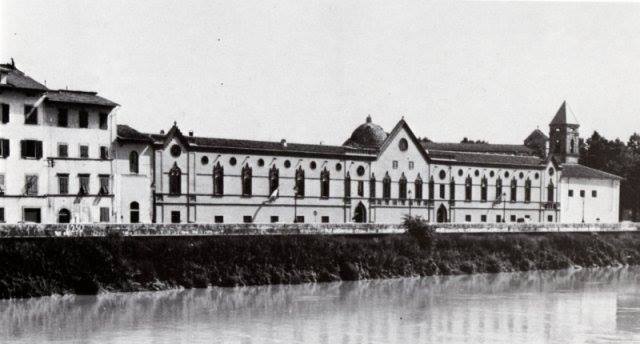The Monastery of Saint Benedict in Pisa was originally built in the early twelfth century on the pisan coast - near San Piero a Grado - as a hermit community. Due the Saracen pirate raids risk, the nuns left the place of their first settlement to seek refuge in town, near the church of San Paolo a Ripa d'Arno, held at that time by Benedictine monks.
The construction of the new monastery dates 1393. The monastery complex - church and convent - was built on the south bank of the Arno river, in an area called "tegularia" in the late Middle Ages by the presence of brick kilns and pottery, as later attested by some archaeological finds inside the monastery.
The structure underwent massive renovations in the sixteenth century, following the nuns passage to the order of Saint Stephen (1565) and again in the seventeenth century, when the facade overlooking Piazza S. Paolo a Ripa d’Arno and the square bell tower with pyramid coverage were built. During the renovation works of 1643 the frescoes of Benozzo Gozzoli depicting stories of St. Benedict were almost totally destroyed; a fragment is now preserved at the Cassa di Risparmio di Pisa headquarters, in piazza Dante.
In 1808, at the time of napoleonic occupation, the monastery was confiscated and the nuns forced to relocate. In 1814, to regain its possession, they accepted the conditions imposed on them by Ferdinand de Lorraine restoring the property at their own expenses. After that, in 1850, along the Arno River a new facade was built, designed by the architect Domenico Santini who invented the three-kiosks dark red, joined by yellow robes on the ground, decorated with terracotta elements. The use of windows in the Flamboyant Gothic style was a novelty for the architectural traditions of Pisa.
The nuns, however, were again removed in 1866, under the new Italian laws on religious orders suppression (the altars, dismantled in 1889, are now preserved in the church of Navacchio) and only in 1940 they regained its possession, as a donation of Queen Elena. After few time, on August 31th 1943, the building was bombed by the allied forces. At the end of the war the nuns asked a few years pantry from seclusion to become beggars and itinerant, in attempt to gain enough to reconstruct the essential.
However, in few years they were forced to think of selling the property, now crumbling and in the '60s they contacted the Benedictine Monastery in Empoli, for the merger of the two monasteries and the construction of Monastery in Pontasserchio, where religious life began on November 13th, 1969.
The Benedictine building on Lungarno, closed to the cult, was later purchased and restored by private, such as the bank Cassa di Risparmio di Pisa - who used it as a venue for meetings and conferences of his Foundation - and later the University of Pisa (for a 50%) that turned it into a guest house for Italian and foreigners students and teachers.
Fonti: sito del comune di Pisa e http://www.benedettinepisa.org

 | ENG
| ENG | ITA
| ITA | FRA
| FRA | UKR
| UKR